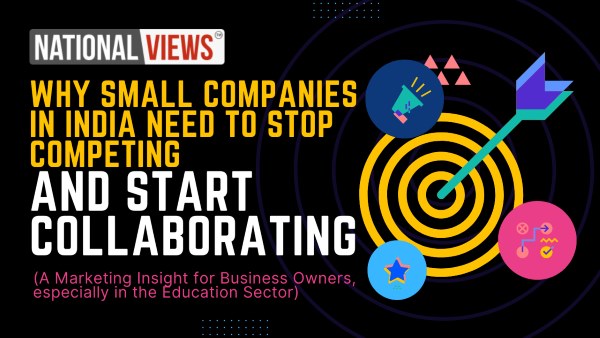(A Marketing Insight for Business Owners of Small Companies in India, especially in the Education Sector)
The Competition Trap of Small Businesses
In India’s fast-growing entrepreneurial ecosystem, small companies in India are mushrooming across every sector — from education and edtech to health, fashion, and consulting. But here’s the irony: instead of building unique identities or exploring partnerships, most small businesses spend their energy copying and competing with one another.
Scroll through LinkedIn or walk through a startup hub, and you’ll notice a repeating pattern — same website templates, similar course offerings, cloned marketing lines, and even identical taglines. Everyone seems to be running the same race, chasing the same audience, and ultimately ending up in the same trap: mediocre growth and mutual burnout.
The truth is simple yet often ignored — competition may fuel ego, but collaboration fuels growth.
The Copycat Syndrome in the Indian Education Sector
Let’s take a brutally honest look at the Indian education and training sector — one of the most over-crowded, over-promised, and under-collaborated industries. Every few months, a new institute pops up with a fancy name, announcing “innovative” programs that are, in reality, rebranded versions of existing ones.
Skill centers, edtech startups, education consultants, certification providers and even digital university founders copy each other’s course structure, fees, even social media posts — all while claiming to be “India’s No. 1.” The focus shifts from creating value to outshining competition, which is the fastest way to stagnate.
Instead of asking, “How can we collaborate to build something transformative?” they ask, “How can we outperform them?”
But here’s the marketing irony — in trying to “outperform” each other, they end up targeting the same limited audience, splitting their potential reach and weakening their individual brand power.
Why Competing Is an Outdated Business Strategy
Competition used to make sense in the industrial era — when scarcity was the rule. But in today’s knowledge-driven, digitally connected world, collaboration beats competition every single time.
Let’s break down why:
Competing Shrinks Your Market, Collaborating Expands It:
When two small players fight for the same slice, both lose. But when they collaborate, they can bake a bigger pie. For example, two training institutes with complementary expertise — one in soft skills and another in AI — can co-create a hybrid program that attracts a wider audience.
Competing Wastes Resources, Collaborating Saves Them:
Instead of duplicating marketing costs and ad spends, companies can share resources, cross-promote, and reduce operational expenses — all while multiplying reach.
Competition Breeds Insecurity, Collaboration Breeds Innovation:
When business owners operate from fear of being “copied,” they become secretive and small-minded. But when they collaborate, they open doors to creativity and collective problem-solving.
Competing Creates Enemies, Collaboration Creates Ecosystems:
Great companies are never built in isolation. Think of India’s startup success stories — they thrive because they’re part of ecosystems where partnerships, not rivalry, are the norm.
Also Read: Four Important Ways to Maximize the Growth of Your Business
The Real Problem of Small Companies in India: Ego Masquerading as Ambition
Let’s call it out — many small business owners, especially in education, confuse ego with entrepreneurship. They believe being a “competitor” makes them powerful. They measure success by how many others they can “beat” rather than how much value they can create.
This mindset is outdated and dangerously limiting. Competing for attention rather than contributing to transformation only builds noise, not brands.
Smart entrepreneurs today don’t fear competition — they co-create opportunities. They know that collaboration is not a sign of weakness but of wisdom.
What Collaboration Looks Like in Action
Imagine if small education companies joined forces instead of fighting:
- A digital marketing institute collaborates with a personality development academy to offer “Marketing with Confidence” programs.
- A skill-based edtech firm partners with a traditional college to offer hybrid certification programs with real-world value.
- A regional training brand joins hands with another to share faculty, digital infrastructure, or research access.
Such partnerships don’t just expand reach — they build trust, credibility, and collective brand authority.
Marketing Lesson: Collaboration Is the New Competitive Advantage
From a marketing lens, collaboration is the most cost-effective growth strategy small businesses can adopt. Why?
Because when two brands collaborate, they merge audiences, stories, and credibility — instantly multiplying visibility. It’s free PR, authentic networking, and market positioning — all rolled into one.
Collaboration also helps small businesses tap into psychological marketing benefits. Consumers today prefer authentic, people-driven brands over cutthroat competitors. A company that uplifts others earns goodwill — a currency far more powerful than paid ads.
Case in Point: The “Together Model” vs. The “Copy Model”
The Copy Model says:
“If they’re doing it, we should too.”
The Together Model says:
“If they’re doing well, let’s partner and grow together.”
The Copy Model leads to saturation.
The Together Model leads to scalability.
The Copy Model depends on competition for motivation.
The Together Model depends on collaboration for momentum.
Conclusion: Compete Less, Collaborate More — The Future Is Collective
The time has come for small companies in India — especially in the Indian education sector — to rethink their approach. Copying each other’s business model doesn’t build an empire; it builds confusion. Competing for the same student base or client pool only shrinks the pie for everyone involved.
Instead, collaboration is the new marketing superpower. When small companies come together, they don’t just share profits — they share purpose. They don’t just grow; they create movements.
So here’s the call to every small business owner reading this — stop fighting shadows. Pick up the phone, reach out to that “competitor,” and say, “Let’s build something bigger together.”
Because in the new era of business, collaboration isn’t optional — it’s survival.



